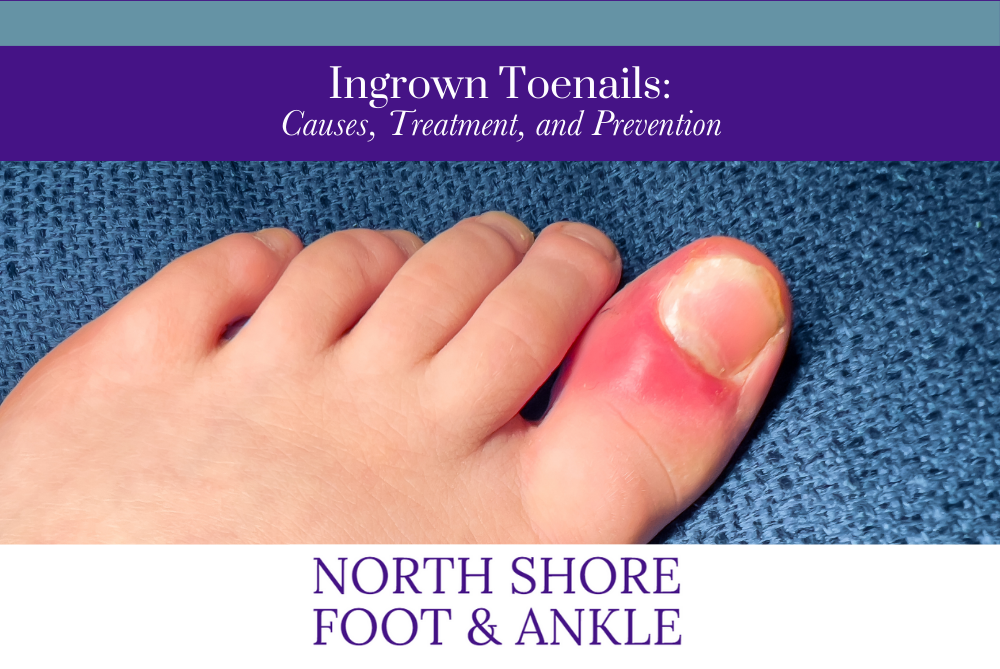
Ingrown toenails are a common yet painful foot condition that can significantly impact daily life. When the corner or side of a toenail grows into the soft flesh of the toe, it can cause pain, swelling, redness, and even infection. While this condition can affect any toe, it most commonly occurs in the big toe. At North Shore Foot & Ankle, our experienced podiatrists are dedicated to providing personalized care for patients suffering from ingrown toenails, helping them find relief and prevent future occurrences.
What Causes Ingrown Toenails?
Ingrown toenails can develop for several reasons, including:
- Improper Nail Trimming: Cutting toenails too short or rounding the edges can encourage the nail to grow into the surrounding skin.
- Tight Footwear: Shoes that crowd the toes can push the nail into the skin.
- Foot Trauma: Injuries, like stubbing a toe or dropping something heavy on it, can lead to abnormal nail growth.
- Genetics: Some people have naturally curved or thick nails that are more prone to becoming ingrown.
- Poor Foot Hygiene: Failing to keep feet clean and dry can increase the risk of infection around the nails.
Symptoms of Ingrown Toenails
Common signs of an ingrown toenail include:
- Pain or tenderness along the sides of the nail
- Redness and swelling around the nail
- Infection signs such as pus or increased warmth
- Difficulty walking due to toe pain
Treatment Options for Ingrown Toenails
At North Shore Foot & Ankle, we offer various treatment options depending on the severity of the ingrown toenail:
- Conservative Care: Soaking the foot in warm, soapy water, applying antibiotic ointments, and using over-the-counter pain relievers can help mild cases.
- Nail Bracing or Splinting: Special devices can help guide the nail to grow correctly without surgery.
- Partial Nail Removal (Partial Nail Avulsion): In more severe cases, part of the nail may need to be removed to prevent recurrence.
- Total Nail Removal: In chronic cases, the entire nail may need to be removed to stop the problem permanently.
- Antibiotics: If the toenail is infected, oral or topical antibiotics may be prescribed.
Preventing Ingrown Toenails
Preventing ingrown toenails involves a few simple steps:
- Trim your toenails straight across, avoiding rounded corners.
- Wear properly fitting shoes with enough room for your toes.
- Keep your feet clean and dry.
- Avoid picking or tearing at your toenails.
- Protect your feet from trauma.
Q&A Section
Q: When should I see a podiatrist for an ingrown toenail? A: You should see a podiatrist if you have persistent pain, signs of infection (like pus or spreading redness), or if you have a medical condition like diabetes that can complicate foot problems.
Q: Can ingrown toenails heal on their own? A: Mild cases may improve with home care, but severe or recurring ingrown nails often require professional treatment to prevent complications.
Q: Is surgery always necessary for ingrown toenails? A: Not always. Conservative treatments can often resolve the issue, but surgery may be recommended if the problem is severe or keeps coming back.
Q: How long does recovery take after ingrown toenail surgery? A: Recovery can vary but generally takes 1-2 weeks for minor procedures and up to 4-6 weeks for more extensive treatments.
Contact Information
North Shore Foot & Ankle
Lynbrook Podiatry Office 50 Hempstead Ave, Ste B Lynbrook, NY 11563 Phone: (516) 599-0302
Syosset Podiatry Office 175 Jericho Turnpike, Suite 300 Syosset, NY 11791 Phone: (516) 496-7676
Flushing Podiatry Office 72-03 164 St. Flushing, NY 11365 Phone: (718) 591-3320
Rosedale Podiatry Office 140-04 248 St Rosedale, NY 11422 Phone: (718) 949-4844
Plainview Podiatry Office 1144 Old Country Rd Plainview, NY 11803 Phone: (516) 942-0620
If you or a loved one is struggling with the pain and discomfort of an ingrown toenail, the experts at North Shore Foot & Ankle are here to help. Contact the nearest location today to schedule an appointment and take the first step toward relief.








